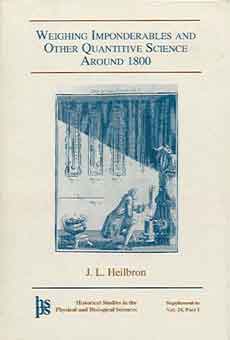 The physical science of the late 18th century invoked a set of qualitatively different sorts of matters, which served as carriers of special-purpose forces. These matters divided into ordinary or ponderable stuff and weightless fluids, able to act on ponderable matter and, in certain cases, on one another. Ordinary matter carries, and exerts upon itself, the forces of gravity, cohesion, chemical affinity, and capillarity. Among the imponderables, the particles of light interact with ordinary matter; the fluid(s) of electricity act on ordinary matter and on one another; the fluids of magnetism behave similarly; and the self-repulsive fluid of heat (caloric) counters the various cohesive forces that, without its intervention, would coagulate all terrestrial ponderable matter into one unleavened lump. Borrowing a term from today's physics, we may call this collection of matters the Standard Model of its time. It represented all the physical phenomena known at the end of the 18th century; it had the unity of a common mathematical dress, if not of a coherent ontology; and it was regarded as a model, not as a direct transcription, of God's blueprint for the creation. The pattern for the Standard Model was the theory of gravitation and the hints at its extension to other phenomena thrown out by Newton in the Queries to his Opticks. For most of the 18th century, however, the fit between calculation and observation that made the reputation of the gravitational theory could not be duplicated in any branch of experimental physics. Beginning around 1770, the situation changed rapidly, as electricity, magnetism, and heat began to yield to the sort of analysis that had ordered the motions of the planets; and just after the turn of the 19th century, the phenomena of capillarity and the behavior of light were brought into the scheme, although in a Pickwickian sense. These achievements inspired and exemplified the program described by Laplace in 1796 and brought almost to realization (or so he thought) by Gay-Lussac in 1809: to perfect terrestrial physics by the same techniques as Newton had used to perfect celestial mechanics.
The physical science of the late 18th century invoked a set of qualitatively different sorts of matters, which served as carriers of special-purpose forces. These matters divided into ordinary or ponderable stuff and weightless fluids, able to act on ponderable matter and, in certain cases, on one another. Ordinary matter carries, and exerts upon itself, the forces of gravity, cohesion, chemical affinity, and capillarity. Among the imponderables, the particles of light interact with ordinary matter; the fluid(s) of electricity act on ordinary matter and on one another; the fluids of magnetism behave similarly; and the self-repulsive fluid of heat (caloric) counters the various cohesive forces that, without its intervention, would coagulate all terrestrial ponderable matter into one unleavened lump. Borrowing a term from today's physics, we may call this collection of matters the Standard Model of its time. It represented all the physical phenomena known at the end of the 18th century; it had the unity of a common mathematical dress, if not of a coherent ontology; and it was regarded as a model, not as a direct transcription, of God's blueprint for the creation. The pattern for the Standard Model was the theory of gravitation and the hints at its extension to other phenomena thrown out by Newton in the Queries to his Opticks. For most of the 18th century, however, the fit between calculation and observation that made the reputation of the gravitational theory could not be duplicated in any branch of experimental physics. Beginning around 1770, the situation changed rapidly, as electricity, magnetism, and heat began to yield to the sort of analysis that had ordered the motions of the planets; and just after the turn of the 19th century, the phenomena of capillarity and the behavior of light were brought into the scheme, although in a Pickwickian sense. These achievements inspired and exemplified the program described by Laplace in 1796 and brought almost to realization (or so he thought) by Gay-Lussac in 1809: to perfect terrestrial physics by the same techniques as Newton had used to perfect celestial mechanics.